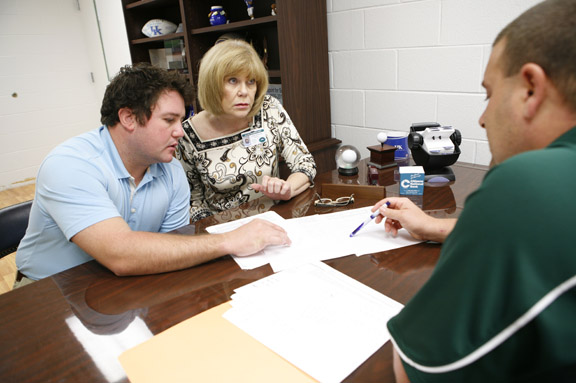
Special education teacher Seth Crisp and curriculum resource teacher Linda Bartrum review test scores with principle Charles Rowe at Allen Elementary School (Floyd County) Sept. 23, 2010. Photo by Amy Wallot
By Matthew Tungate
matthew.tungate@education.ky.gov
Twenty Floyd County teachers are in the final year of a three-year leadership-focused professional development program established through a unique partnership with Morehead State University. Ten of the teachers will receive a master’s degree in School Administration when they complete the program in May.
The core components for the Curriculum, Instruction and Assessment (CIA) Team model that began in the summer of 2008 are leadership; curriculum, instruction and assessment; ongoing professional development; learning community; and change. Besides teachers, cohort members include curriculum resource teachers, assistant principals and principals, according to Patricia Watson, the district’s achievement gap coach/literacy coordinator who is responsible for developing and coordinating the project.
The overall goal is for participants to understand the importance of instructional leadership and the bigger picture that school is to educate all students at high levels.
Sandra Stapleton, a 7th-grade language arts teacher at Allen Central Middle School who has been teaching for 12 years, said the CIA Team has provided a graduate-level education in research-based teaching strategies, commonalities among content teachers within the district for closing achievement gaps, trainings for building a positive school culture. She also “gained insight of myself in the realms of beliefs, behaviors and attitude for education,” she said.
“As a team leader in my school, it is essential for me to continue improvement of leadership skills (how to effectively communicate with people and deal with situations for the greatest success of student learning), and being an active member of content- and grade-level teamwork helps us all reach successful goals,” Stapleton said
Stapleton said she incorporates best practices into her daily lesson plans through activities, technology and assessments, and she shares information and strategies with district colleagues and school-level teams.
“My membership on the CIA team has given me confidence for the role of presenter in needed trainings and causes a desire to seek additional professional learning opportunities where I can better serve the field of education,” Stapleton said.
Linda Samons Bartrum, a 21-year veteran in her 11th year as a curriculum resource teacher/teacher consultant at Allen Elementary School, said she joined the CIA Team to help make better teachers through high-quality professional development, by providing resources and analyzing data, and working in professional learning community meetings to develop data-driven instruction “to provide every student with a high-quality education.”
Rachel Crider teaches intermediate language arts and social studies at McDowell Elementary School, where she has been for 11 years, and she said she has benefited from being part of the CIA Team.
“The most important thing I have learned is to evolve as a future leader,” she said. “I find myself raising the bar of instruction in my classroom daily. I am more research-driven while planning units of study and assessments to reach all my students’ needs. The team has truly changed me as an individual to be a more confident, knowledgeable, team-oriented educator. The benefits just seem to keep coming.”
The idea for the CIA Team began in the spring of 2008, when Floyd County Superintendent Henry Webb approached the Morehead State administration about entering into a partnership to develop a district leadership model involving both theory and practice, according to Rocky Wallace, Morehead State instructor and liaison for the CIA Team.
To design the program, Webb called on Watson, who had recently completed her doctoral degree in educational leadership from the University of Kentucky. Watson’s dissertation was a study of a Kentucky school district’s leadership academy.
Watson said she developed the CIA Team using the Kentucky Department of Education’s Standards and Indicators for School Improvement (SISI) as a rubric for what fully functioning schools should be doing. The five core components stood out through her research and through Floyd County’s needs she said.
“I think it’s a way to equip teachers so that they can help to systematically change or to advance the work in their schools,” Watson said. “We’ve taken teachers and we’re turning them in to leaders.”
Each year, members of the cohort participate in about 50 hours per semester of training. That includes full-day sessions during the summer and in the school year, and after-school sessions. Cohort members also participate in research-based strategies for school improvement, visit schools outside of the district, collect and analyze school data, and lead professional development in their own schools.
Crider’s favorite thing that she has learned comes from author John Maxwell’s laws of teamwork and leadership. She listed Robert Marzano’s Classroom Instruction That Works and Rick Stiggins’ Classroom Assessment for Student Learning as other works she has learned from.
“I can truly say I have grown not only as an individual but as a quality educator to boot,” Crider said.
Bartrum, the curriculum resource teacher, said her position allows her to work with both principals and teachers during their planning to share the information and trainings learned in CIA Team meetings.
“I share with them information that consists from relationships with parents, curriculum issues and test data and, at the present time, we are deconstructing the new core standards in preparation for the new assessment in 2012,” she said.
Crider also has implemented information learned from the CIA Team daily in her classroom and school professional learning community (PLC) meetings, and she continues to look for more.
“I actively assist in developing our school’s (Comprehensive School Improvement Plan) document as a member of the CIA Team as well as assist in the disaggregation of testing data,” she said. “I lead various PLC groups and assist them the deconstructing common core standards and complete common and formative assessments. I also have modeled instructional strategies in various other classrooms at my school, all from CIA-learned material.”
Watson said those kinds of activities are why instructional leadership is so important.
“We’re broadening their scope of thinking about a total school rather than just their own entity in the building,” she said.
Instructional leadership is the foundation on which a strong school is based, Crider said.
“It is the vision that guides the team to success. Without strong instructional leadership, educators would struggle to reach new goals and successfully reach their students’ diverse needs,” she said. “I am very excited about the emphasis that my district has placed upon instructional leadership, and I am surely reaping the benefits as well as my students.”
MORE INFO …
Patricia Watson, patricia.watson@floyd.kyschools.us, (606) 886-2671, ext. 3106




The CIA team has been a vital resource connection for Betsy Layne Elementary School. Through the work of this team, our staff remains on top of current research and skills that all teachers should know. I applaud Dr. Patricia Watson and Superintendent Henry Webb for their continued focus on the professional development of teachers and leaders, which directly affects the success of our students.
I’m proud to be a Floyd County employee.
John A. Kidd,
Principal, BLES